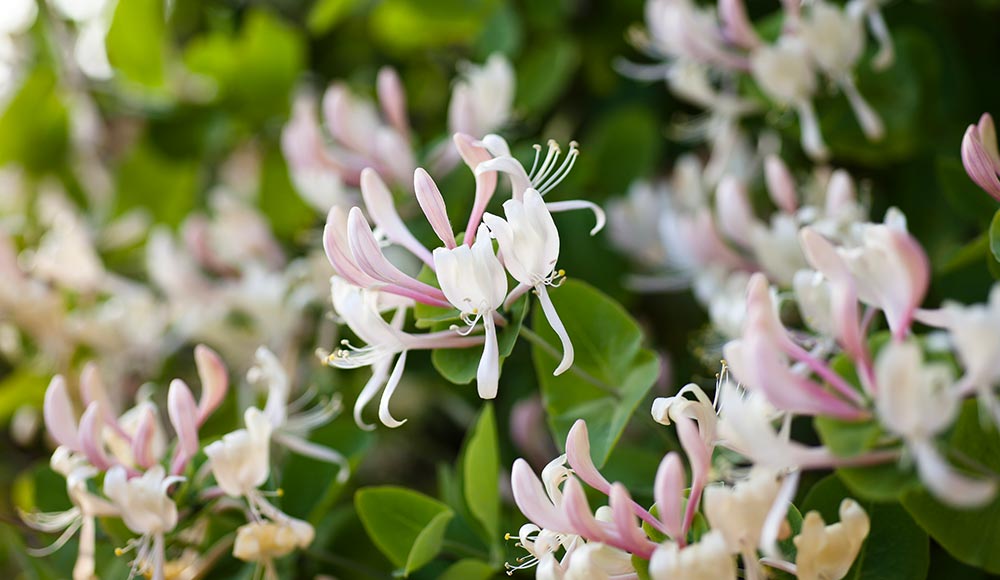


By Gilmour
Honeysuckle is known for its delicate tubular, nectar-filled, sweetly scented flowers. They are great for covering walls and the sides of building. While their roots should be shaded, they do best when their overflowing, flowering tops are mostly in sunlight or just slightly shaded. They are deer-resistant and hummingbirds and other wildlife love them.
Wondering how to grow honeysuckle? Read on for everything you need to know about this easy-to-grow plant, from popular varieties to how and when to plant honeysuckle. We’ll cover:
Honeysuckle is a heat tolerant plant that can grow almost anywhere. With dark green to blue-green leaves and sweet-smelling flowers, they grow as either far-reaching vines or arching shrubs. The flowers can bloom in gorgeous bright pinks, oranges, yellows or whites, and some varieties have a unique two-colored flower. Sweet and nectar-filled, the flowers attract butterflies, hummingbirds and bees, and birds enjoy the small red berries that emerge after flowering. If care is taken to deadhead, these beauties can repeat-bloom often throughout the growing season.
There are close to 200 different varieties of honeysuckle. Native to the northern hemisphere, at least 20 of them are found in North America. There are three types of honeysuckle – vines, shrubs and a bush variety.
Honeysuckle Vines. The honeysuckle vine is a common, simple-to-grow climber that’s available in many varieties. Vines can also be planted as ground cover, but they’re most often trellis-trained to cover walls and structures.
Honeysuckle Shrubs. The honeysuckle shrub is a great choice to use as an informal hedge, and several shrub varieties will actually do surprisingly well in pots and containers.
Bush Honeysuckle. One of the more invasive types of honeysuckle, bush honeysuckle should not be planted in your garden or yard. Bush honeysuckle grows quickly, invading and shading out other areas of your garden.

Training – To train a honeysuckle vine to grow up a pergola, wall or trellis, gently tie the plant to the support with a plastic tie tape or another stretchy material that will allow for growth. You don’t want the material to cut into the plant as it grows. Also take care that the stems don’t rub on the supports – you can do this by looping your ties into a figure 8, making sure the crossed section goes between the stem and the support.
Pruning – You won’t need to spend too much time pruning your plant, other than to keep the shape tidy and contained.
How and when you prune depends on whether you have a vine or bush. Vines can be lightly pruned for shaping virtually any time of the year. If you’re doing a major pruning job on an older vine or one that’s unruly, wait until at least fall, or winter if you have a variety that goes dormant. Bushes can be pruned as soon as flowers drop in the spring.
Use bypass pruners to remove any dead, diseased or damaged stems. Cut stems to the point where they join another stem or just past a leaf node.
If you have planted an evergreen variety, note these will not go dormant. Prune them after the end of the flowering season so you don’t remove new buds.
Tip 1. Honeysuckle plants should be well (but not over) watered and mulched.
Tip 2. Take care not to let your soil get soggy – water only as needed to keep soil moist and damp.
Tip 3. Add layers of compost each spring.
Tip 4. Pruning depends on the type of honeysuckle you plant. Be sure you know which variety you have. – for example, common honeysuckle blooms on side shoots from the previous season, so if you prune it in the spring, you would eliminate your flowers.
Tip 5. Encourage and promote growth with a low-nitrogen fertilizer, a slow-release shrub and tree fertilizer or an organic plant food applied in the spring. You can also add a 2 – 3-inch layer of composted manure. However, if you plant honeysuckle in fertile soil, you may not need to fertilize.
Keep your honeysuckle blooming by making sure the plant is in a spot that gets full sun. Honeysuckle will still grow, but will not bloom as much, in shady spots. Full sun means 6 or more hours of sunlight each day.
If your plant is young, it may just not have reached its full bloom potential yet – note that honeysuckle may take up to 3 years before it puts on a great show.
Honeysuckle is a perennial plant, meaning it will come back each year. With proper care, you should be able to enjoy your honeysuckle for many years. Some varieties can live an average of 20 years.
Honeysuckle is a fast-growing plant that will likely bloom during its first growing season. However, it could take up to 3 years for optimal blooming.
From the moment you pick it up, you’ll notice these nozzles are different. Designed with mobility in mind, they feature Gilmour’s innovative Swivel Connect. The swivel allows the nozzles to pivot without
Learn MoreWinter Gardening Tips to Tackle in the Off Season
As winter marches on, avid gardeners become more and more eager to get growing. While you may not be able to dig your spade into the soil just yet, there is plenty
Learn MoreDesign a Beautiful Drought Resistant Yard
Hot weather and drought-like conditions don’t mean a beautiful yard and garden is out of reach. Learn everything you need to know about drought tolerant landscaping, including the best type of plants,
Get the Dirt